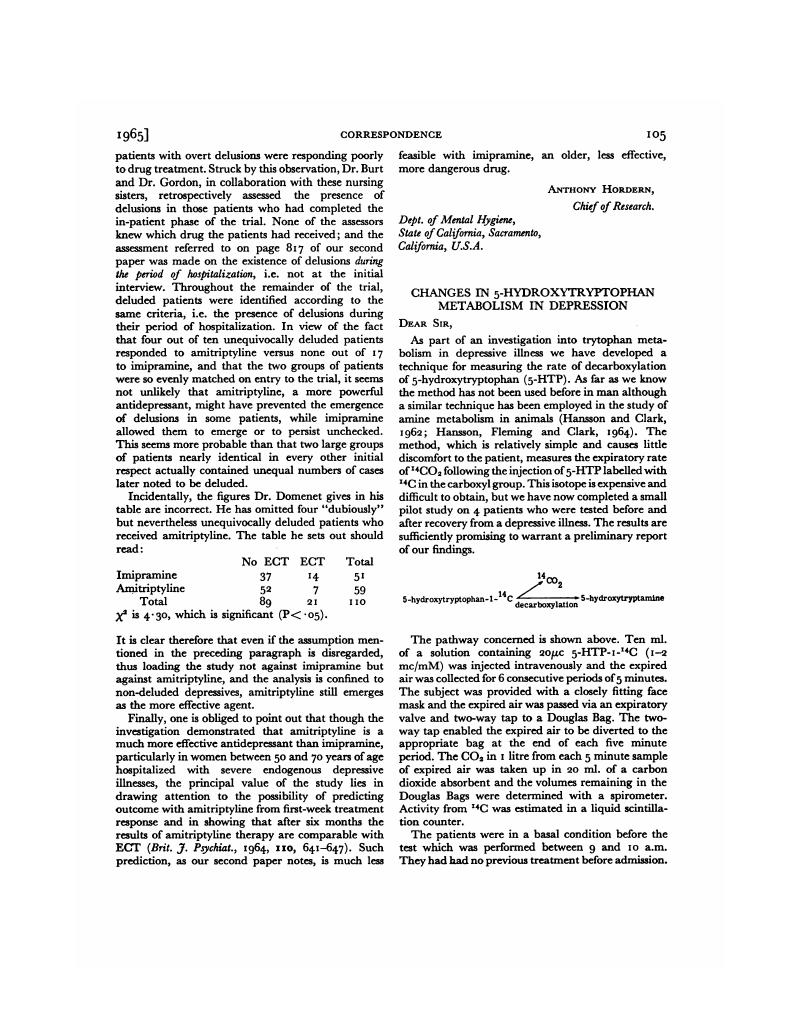Crossref Citations
This article has been cited by the following publications. This list is generated based on data provided by Crossref.
Coppen, A.
Shaw, D. M.
Malleson, A.
Eccleston, E.
and
Gundy, G.
1965.
Tryptamine Metabolism in Depression.
British Journal of Psychiatry,
Vol. 111,
Issue. 479,
p.
993.
RICHTER, DEREK
1967.
Amines and Schizophrenia.
p.
167.
Coppen, Alec
1967.
The Biochemistry of Affective Disorders.
British Journal of Psychiatry,
Vol. 113,
Issue. 504,
p.
1237.
Schildkraut, Joseph J.
and
Kety, Seymour S.
1967.
Biogenic Amines and Emotion.
Science,
Vol. 156,
Issue. 3771,
p.
21.
1967.
Biochemistry of Depression.
The Lancet,
Vol. 289,
Issue. 7485,
p.
317.
Glen, A.I.M.
Ongley, G.C.
and
Robinson, K.
1968.
DIMINISHED MEMBRANE TRANSPORT IN MANIC-DEPRESSIVE PSYCHOSIS AND RECURRENT DEPRESSION.
The Lancet,
Vol. 292,
Issue. 7562,
p.
241.
Coppen, A.J.
and
Smythies, J.R.
1968.
Biological Psychiatry.
p.
50.
Takahashi, Ryo
Nagao, Yoshiko
Tsuchiya, Kenji
Takamizawa, Misa
Kobayashi, Teruyoshi
Toru, Michio
Kobayashi, Kenichi
and
Kariya, Tetsuhiko
1968.
Catecholamine metabolism of manic-depressive illness.
Journal of Psychiatric Research,
Vol. 6,
Issue. 3,
p.
185.
Dewhurst, W G
1969.
Studies in Cerebral Amine Metabolism [Abridged].
Proceedings of the Royal Society of Medicine,
Vol. 62,
Issue. 11P1,
p.
1102.
Roos, B. E.
and
Sj�str�m, R.
1969.
5-hydroxyindoleacetic acid (and homovanillic acid) levels in the cerebrospinal fluid after probenecid application in patiens with manic-depressive psychosis.
Pharmacologia Clinica,
Vol. 1,
Issue. 4,
p.
153.
Davies, Brian
1969.
RECENT STUDIES OF SEVERE DEPRESSIVE ILLNESSES: PART 2.
Medical Journal of Australia,
Vol. 1,
Issue. 11,
p.
557.
Schildkraut, Joseph J.
1969.
Neuropsychopharmacology and the Affective Disorders.
New England Journal of Medicine,
Vol. 281,
Issue. 6,
p.
302.
Meek, J.
Fuxe, K.
and
Andén, N.-E.
1970.
Effects of antidepressant drugs of the imipramine type on central 5-hydroxytryptamine neurotransmission.
European Journal of Pharmacology,
Vol. 9,
Issue. 3,
p.
325.
Davis, John M.
1970.
Vol. 12,
Issue. ,
p.
145.
VAN PRAAG, H. M.
KORF, J.
and
PUITE, J.
1970.
5-Hydroxyindoleacetic Acid Levels in the Cerebrospinal Fluid of Depressive Patients treated with Probenecid.
Nature,
Vol. 225,
Issue. 5239,
p.
1259.
McNamee, H.B.
Moody, J.P.
and
Naylor, G.J.
1972.
Indoleamine metabolism in affective disorders: Excretion of tryptamine, indoleacetic acid and 5-hydroxyindoleacetic acid in depressive states.
Journal of Psychosomatic Research,
Vol. 16,
Issue. 1,
p.
63.
1973.
Serotonin and Behavior.
p.
569.
Riederer, P.
Birkmayer, W.
and
Neumayer, E.
1973.
The tyrosine-tryptophan-diagram in a longtime study with depressed patients.
Journal of Neural Transmission,
Vol. 34,
Issue. 1,
p.
31.
Riederer, P.
Birkmayer, W.
Neumayer, E.
Ambrozi, L.
and
Linauer, W.
1974.
The daily rhythm of HVA, VMA, (VA) and 5-HIAA in depressionsyndrom.
Journal of Neural Transmission,
Vol. 35,
Issue. 1,
p.
23.
Coppen, Alec
Brooksbank, Benjamin W. L.
Eccleston, Eric
Peet, Malcolm
and
White, Stuart G.
1974.
Tryptophan metabolism in depressive illness.
Psychological Medicine,
Vol. 4,
Issue. 2,
p.
164.




eLetters
No eLetters have been published for this article.